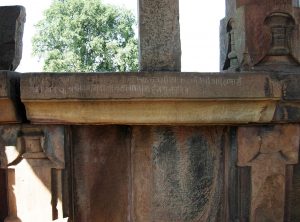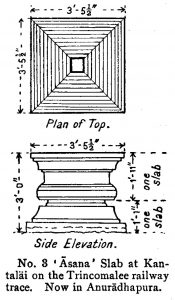Madanpur temple inscription dated 1235

Madanpur (Lalitpur district, UP). Temple maṇḍapa inscription of VS 1235.
OB03085 Kantaläi Gal-Āsana Inscription of Kitti Nissaṅka-Malla
Diagram of the Kantaläi gal-āsana. Published in: Wickremasinghe, Don Martino de Zilva. (1912-27). ‘No. 42. (Reg. No. 3.) Kantaläi Gal-Āsana Inscription of Kitti Nissaṅka-Malla (1187–1196 A.D.),’ Epigraphia Zeylanica 2, p. 283.
IN03105 Kantaläi Gal-Āsana Inscription of Kitti Nissaṅka-Malla
The inscription is engraved around the four sides of a stone seat (gal–āsana), which was discovered in 1921 in the village of Kantaläi on the Trincomalee Railway and afterwards removed to Anurādhapura. The text identifies the stone seat as the one that king Nissaṅka-Malla, after returning from his Indian campaign, used to occupy whilst witnessing the various diversions such as alms-giving, dancing, singing, etc., in the Pārvatī-satra erected at his request in Caturveda-Brahmapura, ‘the city of the Four-Vedic Brahmans’. By way of an introduction, the inscription also includes a bombastic account of Nissaṅka-Malla’s military achievements and charitable acts. Virtually identical accounts are commonly found in other gal-āsana records of this king. The Kantaläi inscription is not dated but, since it references his tours of inspection and his expedition to India, it was probably composed towards the end of his short but eventful reign, which spanned nine years, beginning in 1187 and terminating in 1196. If Kantaläi was the original site of the seat, then this locality must once have been the town called Caturveda-Brahmapura, which was probably occupied mostly by Brahman families for whose benefit an almshouse called Brāhmaṇa-satra was also established by Nissaṅka-Malla.
OB03070 Poḷonnaruva Kiri-Vehera Slab
Kiri-Vehera Dagaba, Polonnaruwa
IN03090 Poḷonnaruva Kiri-Vehera Slab Inner Inscription
This text is the inner inscription on the upper surface of a stone slab found lying on the maḷuva or terrace of the so-called ‘Kiri-vehera’ dāgaba in Poḷonnaruva, about eight or ten yards to the south-east of its south altar. The slab has two inscriptions. The first or outer inscription is engraved around all four edges of a large rectangular area, which covers almost the entire surface of slab. The second or inner inscription is engraved around all four edges of a smaller rectangular area, which is set within the first inscription. An ornamental border of swans (haṁsas) and foliage surrounds the outer inscription and a conventional crab and fish pattern frames the inner one.
Both inscriptions date from the reign of king Niśśaṅka-Malla. It is obvious from the contents of the two texts and from the few stumps of pillars still existing round the slab that it was originally situated inside a kūḍama or pavilion structure similar in style to the one at the Rankot-dāgaba (OB03067) and built about the same period, namely, between 1191 and 1196 A.D. The inscribed slab must have been the flagstone of a raised seat within the pavilion, from which the royalty was wont to worship the relics enshrined in the Kiri-vehera-dāgaba opposite.
The text of the first or outer inscription is the same as the Poḷonnaruva Stone Bath Slab Inscription (IN03088), the only exception being the concluding clause which indicates the pavilion (kūḍama), as the one from which His Majesty Kīrti Niśśaṅka-Malla worshipped the (Buddhist) relics.
OB03069 Poḷonnaruva Śiva-Devālaye Slab
Shiva Dewalaya No. 1, Polonnaruwa
IN03089 Poḷonnaruva Śiva-Devālaye Slab Inscription
The inscription is engraved around all four edges of the smoothed upper surface of a quadrangular slab, which once formed the top flagstone of a raised seat (āsana). It was examined by H. C. P. Bell sometime between 1901 and 1905. The slab was then lying inside a ruined shrine referred to by Bell as Śiva-Devālaya No. 1 and situated a little to the south of the main group of Buddhist ruins on the raised quadrangle near Tōpaväva. The stone is badly worn, rendering a considerable portion of the inscription totally illegible. However, what remains readable clearly shows that the text agrees almost word for word with the Poḷonnaruva Stone Bath Slab Inscription (IN03088), the only exception being the concluding sentence which indicates the inscribed seat or āsana as the one which king Niśśaṅka-Malla used to occupy when performing the function of lustral bathing (nānu mē) at the ceremony of propitiating the nine planetary gods (nava-graha-śānti). Niśśaṅka-Malla reigned from 1187 to 1196 A.D. No specific date is given in the inscription but the text must have been composed after the fourth year of the king’s reign because it refers to his visit to Anurādhapura, which took place in his fourth regnal year.
OB03066 Poḷonnaruva Rankot-Dāgaba Gal-Āsana
Rankoth Vehera, Polonnaruwa.
IN03086 Poḷonnaruva Rankot-Dāgaba Gal-Āsana Inscription
The inscription is engraved around four sides of the smoothed upper surface of a stone seat (āsana). It was discovered in the jungle some two hundred yards to the east of the ruin known as Ran-kot-vehera in Poḷonnaruva. The inscription consists of six lines and dates from the reign of Niśśaṅka-Malla (1187-1196 A.D.). It gives an account of some of Niśśaṅka-Malla’s acts, before identifying the seat as the one which the king occupied to watch the construction of the Ruvanväli-dāgaba at Poḷonnaruva. Wickremasinghe notes that the stone-seat inscription must be earlier than the Galpota inscription (IN03081) because the latter post-dates the completion of the Ruvanväli-dāgaba. This dāgaba was built to a height of eighty cubits and adorned with a golden pinnacle, from which it gets its present name: Ran-kot-vehera (‘golden-spire-monastery’).
OB03065 Poḷonnaruva Kāliṅga Park Gal-Āsana
Niśśaṇka-Malla’s Council Chamber, Polonnaruwa.




